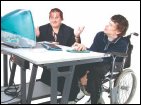
So, the list would look like this:
Today, do you want to
clean the bathroom
or clean the lobby
or clean the mud off your boots
or wipe the kitchen counters?
Even better, write:
Here are some things you can do.
Do you want to clean the bathroom?
Do you want to clean the lobby?
Do you want to clean the mud off your boots?
Or do you want to wipe the kitchen counters?
Repetitious, I know, but at least the meaning doesn’t become lost while the choices are being read. Using bullets may help too, though some people find them irritating.

Testing
Document testing is particularly important for materials intended
for people with developmental disabilities. Readers are unlikely
to use a dictionary if they don’t understand what you have written.
And you, if you are reading this, are not in the shoes of most
people with developmental disabilities, so you are guessing (albeit
maybe with much learned knowledge) what is understandable.
Before testing with lower-literacy readers, make sure the document
is in a large, clear font. Otherwise you will be testing eyesight rather
than the resource. There is more information on fonts in chapter 10.
Illustration
Pictures can play a very important role in easy-to-read materials. They
make reading more interesting for everyone, especially those facing literacy
barriers. Like text, though, images can mislead and confuse. They need to
be chosen with care and tested, just as you would test the writing. Much of
what we “see” in pictures depends upon our life experiences. As writers,
educated and comfortable with words, many of our experiences will likely
be different from those of people with developmental disabilities.
Mostly, I imagine, you will be using clipart. The choices offered have improved greatly over the last ten years. Thank goodness! But you may still search to find exactly the right pictures, particularly those of people with disabilities. On the plus side, clipart takes up relatively little space in your file and the pictures are easy to use.

In this chapter, I have put doubtful choices of pictures on the left side of the page, and better choices on the right.
Photos can be useful but take up much more space and can lead to simply enormous files. Also, they usually need plenty of space on the page. You cannot slip one in beside every couple of sentences. They must be printed large enough that the details can be easily seen. Many photos, too, have fussy backgrounds which make them harder to “read.” If you intend to use your own photos, make sure the background is plain and you have the consent of the people in the picture.